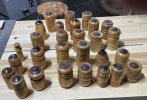This collection of boxes are from some timber scraps of a house built in 1815 that was in part of my wife's family. I turned these a "mementos" for members of her family. They all look similar in shape and size primarily because I was maximizing the use of the wood and the cavity inside the boxes. The walnut is from a tree felled on family property some 50 years ago. My shop smelled like a turpentine factory during this entire project! The finish on all is just a shellac friction polish. The boxes are certainly not the greatest work in the world, but will be fine for their purpose. I only had one "explode" on me during the project, but I also tried not to turn anything with too many cracks. You will see some have some significant cracks in the surface.
You are using an out of date browser. It may not display this or other websites correctly.
You should upgrade or use an alternative browser.
You should upgrade or use an alternative browser.
Wooden Box Turnings
- Thread starter Mark Johnson
- Start date
I didn't use either. These were just turned with the lid on, then the lid separated and the boxes drilled.Very interesting wood grain!
Did you use a Beall box mandrel or jam chuck?
The walnut is a great accent. They look great! Did you have a plan so they would be different? Did you just go for it? I'll taking down an old small barn on family property. This would be a great project for some of the beams. The family gathering at Christmas would be a wonderful time to give them out.
I did not have a specific plan for the differences. The OD and ID were pretty much fixed by the wood block size and the forstner bit I had. I simply turned based on the particular block of wood and the piece of walnut I had for it. As an example, all of the walnut came from some unused spindles so some of the pieces were longer than the others and they became the more finial types. This also meant that the walnut was all end grain in appearance which takes a darker finish color and frankly is less interesting from a grain pattern standpoint. If the pine had a crack (and many blocks did), then I did not try to do any shaping beyond getting somewhat smooth and burning grooves. Some of the differences were just wanting to try something different, especially on the textured lids. I just wanted to see what holding the tool a particular way would do. Thanks for asking.The walnut is a great accent. They look great! Did you have a plan so they would be different? Did you just go for it? I'll taking down an old small barn on family property. This would be a great project for some of the beams. The family gathering at Christmas would be a wonderful time to give them out.
LOL. Been there.My shop smelled like a turpentine factory during this entire project!
Some of those boxes appear to have some tight annular rings indicating old growth yellow pine.
Nice!
This was definitely old growth pine. Probably cut around 1813, and had to have been some massive trees.LOL. Been there.
Some of those boxes appear to have some tight annular rings indicating old growth yellow pine.
Nice!
You did good saving that piece of botanical history. All too often wood like that ends up as firewood. Some of those pieces look like it took the tree twenty-five years or more to grow two inches in girth. It takes a steady hand and a sharp tool to cut a smooth curve on yellow pine because of the radical hardness differences between the early wood and the late wood.
I don't know how steady my hand was, but the tools were as sharp as I could get them! The skew was honed probably with each box, and even the roughing gouge got a lot of attention.You did good saving that piece of botanical history. All too often wood like that ends up as firewood. Some of those pieces look like it took the tree twenty-five years or more to grow two inches in girth. It takes a steady hand and a sharp tool to cut a smooth curve on yellow pine because of the radical hardness differences between the early wood and the late wood.
LATEST FOR SALE LISTINGS
-
-
-
SOLD -- $75: Gast moa v113 Vacuum Pump Veneer, 60" bag and board
- Started by peterdnight
- Replies: 1
-
GONE: Gladiator 5 cleats, 10 hangers, Paper Towel and Shelf
- Started by peterdnight
- Replies: 3
-
SOLD -- $100 Makita mac700 portable air + grex pin nailer + 2 others + 50' hose
- Started by peterdnight
- Replies: 1

